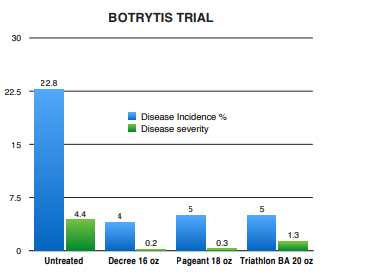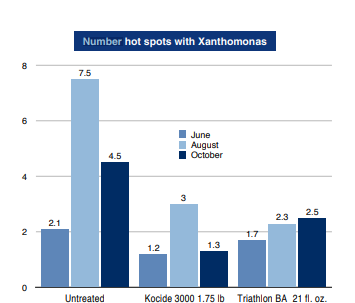Knowde Enhanced TDS
Identification & Functionality
- Agrochemical Functions
- Technologies
- Product Families
- Composition
ACTIVE INGREDIENT: Bacillus amyloliquefaciens strain D747* 98.85% OTHER INGREDIENTS 01.15% TOTAL 100.0% * Contains a minimum of 1×1010 colony-forming units (cfu) per milliliter
Features & Benefits
- Agrochemicals Features
- Product Highlights
Triathlon BA is OMRI listed and approved for use in organic production.
- Common Name: Bacillus amyloliquefaciens strain D747
RESTRICTED ENTRY INTERVAL (REI) AND SIGNAL WORD
- REI = 4 hours
- Signal Word = CAUTION
- Benefits
- Effective on fungal and bacterial diseases
- Spray or drench applications
- Part of a traditional or organic program
- Labeled for use on fruits, vegetables, and herbs
- Key Diseases Controlled
- Alternaria
- Anthracnose
- Bacterial leaf spot
- Botrytis
- Downy mildew
- Fusarium Leaf spots
- Phytophthora
- Powdery mildew
- Pythium
- Rhizoctonia
- Rust
- Scab
- Summary
Summary of trials to date
Disease Results Alternaria leaf spot variable Blue mold (downy mildew) variable Botrytis good to excellent Fireblight some Powdery mildew some to very good Rhizoctonia damping-off and leaf spot good to very good Rust variable Xanthomonas blight and leaf spot very good to excellent BOTRYTIS TRIAL

Number hot spots with Xanthomonas

- General Information
TRIATHLON BA is a broad-spectrum preventative biofungicide/bactericide for control or suppression of fungal and bacterial plant diseases. The active ingredient of TRIATHLON BA is a naturally occurring strain (D747) of the beneficial bacterium Bacillus amyloliquefaciens. TRIATHLON BA also colonizes plant root hairs, preventing establishment of disease-causing fungi and bacteria. TRIATHLON BA can be applied alone or in combination and/ or rotation with chemical fungicides as a tool for integrated disease management in agricultural crops, ornamental and nursery plants, and turfgrass. TRIATHLON BA offers a valuable tool for management of resistance to chemical fungicides through its multiple and unique modes of action. TRIATHLON BA can be applied up to and including the day of harvest.
Applications & Uses
- Markets
- Applications
- Applicable Crop
- Application Technique
- Fungicide Target Species
- Use Sites
Triathlon BA may be used both indoors and outdoors on ornamental flowering plants, vegetables, herbs, trees, shrubs, and foliage grown in nurseries, greenhouses, shadehouses and on turfgrass.
- Application
Triathlon BA works as a contact foliar spray or drench to prevent diseases caused by fungi and bacteria on foliage and roots. Weekly foliar sprays may be necessary to protect new growth on ornamentals, trees, and shrubs.
- Tank Mixing
Triathlon BA may be applied alone or in combination and/or rotation with other fungicides and bactericides as a tool for integrated disease management in ornamental and nursery plants and on turfgrass. To mix Triathlon BA, fill spray tank to ½ capacity with constant agitation. Do not use highly alkaline or highly acidic water to mix sprays. Use a buffering agent if necessary to maintain neutrality (pH 6 - 8) of water in the tank. Do not allow spray mix to stand overnight.
- Application Rates
Foliar: Triathlon BA should be sprayed at 3 to 10 day intervals at a rate of 0.5 quarts to 6 quarts per 100 gallons
Drench: Mix 0.5 to 4.5 pints per 100 gallons and apply as a coarse spray or drench to soil or media in pots.
Cutting or root dip: Dip basal end of cuttings or bare roots (individually or in bunches) in a suspension of 1 to 2 pints per gallon of water. Immerse for 5 - 10 seconds immediately before planting.
Chemigation: Mix 0.5 to 4.5 pints per 100 gallons of water and apply via drip, handheld, or sprinkler irrigation systems.
Phytotoxicity: Triathlon BA should be trialed first before widespread application to open blooms. Refer to the label for precautions on tender foliage and flowers
- Directions For Use
It is a violation of Federal law to use this product in a manner inconsistent with its labeling. For any requirements specific to your State or Tribe, consult the State or Tribal agency responsible for pesticide regulation.
Do not apply this product in a way that will contact workers or other persons, either directly or through drift. Only protected handlers may be in the area during application
- Agricultural Use Requirements
Use this product only in accordance with its labeling and with the Worker Protection Standard 40 CFR Part 170. This standard contains requirements for the protection of agricultural workers on farms, forests, nurseries, and greenhouses and handlers of agricultural pesticides. It contains requirements for training, decontamination, notification, and emergency assistance. It also contains specific instructions and exceptions pertaining to the statements on this label about personal protective equipment (PPE), and restricted entry intervals. The requirements in this box only apply to uses of this product that are covered by the Worker Protection Standard
Do not enter or allow worker entry into treated areas during the restricted entry interval (REI) of 4 hours.
PPE required for early entry to treated areas that is permitted under the Worker Protection Standard and that involves contact with anything that has been treated, such as plants, soil or water is: coveralls, waterproof gloves, shoes plus socks.
Exception: If the product is soil injected or soil incorporated, the Worker Protection Standard, under certain circumstances, allows workers to enter the treated area if there will be no contact with anything that has been treated.
- Non-Agricultural Use Requirements
The requirements in this box apply to uses of this product that are NOT within the scope of the Worker Protection Standard for agricultural pesticides (40 CFR Part 170). The WPS applies when this product is used to produce agricultural plants on farms, forests, nurseries, or greenhouses. Keep unprotected persons out of treated areas until sprays have dried
- Mixing And Handling Instructions
Mix the required amount of TRIATHLON BA in water with sufficient agitation to maintain a uniform suspension in the spray or mixing tank. Tank should be cleaned prior to use. Do not use highly alkaline or highly acidic water to mix sprays. Use a buffering agent if necessary to maintain neutrality (pH 6 to 8) of water in the tank. Maintain agitation during application. Apply immediately after mixing; do not allow spray mix to stand overnight.
TRIATHLON BA can be mixed and used with other agricultural chemicals for which such mixing is permitted by the product labels, in accordance with the most restrictive of those label limitations and precautions. If such a mixture is planned, a compatibility “jar test” should first be conducted by mixing the correct proportions of TRIATHLON BA and these products in a small volume of water.
- Application Methods
Ground: TRIATHLON BA can be applied in most commonly-used ground application equipment, such as (but not limited to): tractor-mounted boom, airblast, high clearance, hose-end, backpack, and other pressurized sprayers; hose-end or handheld sprayers; foggers or mist blowers; water wheel and other drench applicators; and shank or other soil injection method. Aerial: TRIATHLON BA can be applied by fixed or rotary winged aircraft in a minimum of 3 gallons of water per acre. Standard precautions should be taken to minimize spray drift. Chemigation: TRIATHLON BA can be applied through drip (trickle) and sprinkler type irrigation equipment. Refer to the section entitled “Chemigation Instructions” for detailed instructions.
Safety & Health
- Personal Protective Equipment (Ppe)
- Long-sleeved shirt and long pants
- Waterproof gloves
- Shoes plus socks
- Dust/mist filtering respirator meeting NIOSH standards
- Precautionary Statements
HAZARDS TO HUMANS AND DOMESTIC ANIMALS
CAUTION Prolonged or frequently repeated skin contact may cause allergic reactions in some individuals. Avoid contact with eyes, or clothing. Avoid breathing spray mist. Wash thoroughly with soap and water after handling and before eating, drinking, chewing gum, using tobacco and using the toilet.
- User Safety Recommendations
- Remove clothing/PPE immediately if pesticides get inside. Then wash thoroughly and put on clean clothing
- Remove PPE immediately after handling this product. Wash the outside of gloves before removing. As soon as possible, wash thoroughly and change into clean clothing.
- Environmental Hazards
For Terrestrial Uses: Do not apply directly to water or to areas where surface water is present, or to intertidal areas below the mean high water mark. Do not contaminate water when disposing of equipment washwaters or rinsate. Do not apply when weather conditions favor drift or runoff from treated areas
Packaging & Availability
- Packaging Type
- Packaging
- Triathlon BA is packaged in 1 gallon containers, 4 per case.
Storage & Handling
- Storage And Disposal
Do not contaminate water, food, or feed by storage and disposal.
Pesticide Storage: Store in a dry area inaccessible to children. Store in original containers only. Keep container closed when not in use.
Pesticide Disposal: Wastes resulting from the use of this product may be disposed of onsite or at an approved waste disposal facility.
Container Handling: Nonrefillable container. Do not reuse or refill this container. -for containers equal to or less than 5 gallonsTriple rinse container (or equivalent) promptly after emptying. Triple rinse as follows: Empty the remaining contents into application equipment or a mix tank and drain for 10 seconds after the flow begins to drip. Fill the container 1/4 full with water and recap. Shake for 10 seconds. Pour rinsate into application equipment or a mix tank or store rinsate for later use or disposal. Drain for 10 seconds after the flow begins to drip. Repeat this procedure two more times. Then offer for recycling, if available or puncture and dispose of in a sanitary landfill, or by incineration, or if allowed by state and local authorities, by burning. If burned, stay out of smoke.